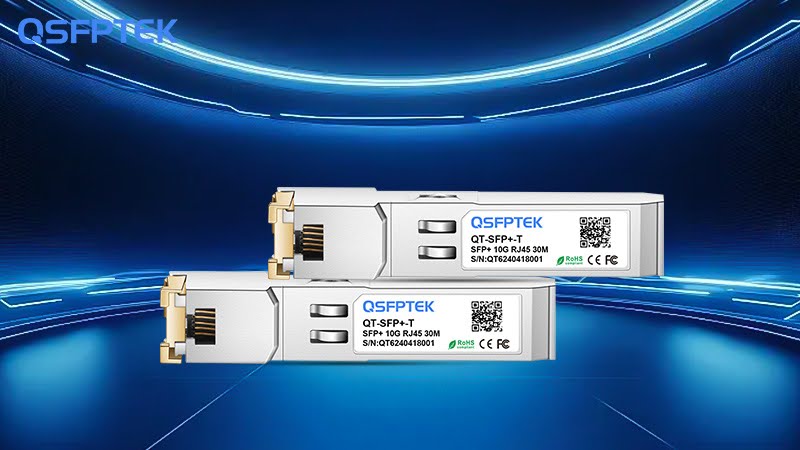Introduction: The Rise of High-Speed Networking
As networking demands continue to soar with the rise of data-intensive applications, cloud computing, and artificial intelligence, Ethernet technology has rapidly evolved. Speeds of 25G, 40G, and even 100G are becoming commonplace in enterprise and data center environments. In this context, 10GBASE-T SFP+ modules may seem outdated. However, despite the emergence of faster alternatives, 10GBASE-T SFP+ still offers a set of advantages that make it a relevant and cost-effective solution in specific scenarios.
What Is 10GBASE-T SFP+?
10GBASE-T SFP+ refers to a type of 10G SFP+ module that delivers 10 Gigabit Ethernet over standard twisted-pair copper cables using the SFP+ form factor. With an RJ45 connector and support for Cat6a or Cat7 cabling, it offers a reach of up to 100 meters. One of its most valuable features is backward compatibility with 5G, 2.5G, and 1G Ethernet speeds, making it ideal for mixed-speed network environments. Its plug-and-play design, combined with compatibility with existing copper infrastructure, allows for flexible deployments in access switches, legacy server uplinks, and enterprise network upgrades.
Why 10GBASE-T SFP+ Still Matters
The 10GBASE-T transceivers continue to hold their ground due to several practical strengths. First, it is highly cost-effective. Copper cabling is significantly cheaper than fiber, especially for short-distance deployments, and many businesses already have structured Cat6a or Cat7 cabling in place. This means network upgrades can often be achieved without expensive re-cabling or the need to adopt fiber-optic components.
Second, 10GBASE-T SFP+ offers excellent flexibility in deployment. Since RJ45 connectors are nearly universal in network devices—from switches and servers to routers—these modules can be deployed quickly and conveniently, regardless of the environment. Moreover, they support auto-negotiation across a range of Ethernet speeds, allowing smooth integration with both legacy and modern equipment. This backward compatibility reduces the complexity and cost of network upgrades, especially in environments where not all devices support 10G speeds.
Another practical advantage is ease of use. These modules offer plug-and-play operation with standard copper cables, eliminating the need to match fiber types or worry about cleaning connectors. For many network administrators, this simplicity results in faster, less error-prone deployments.
The Limitations of 10GBASE-T
Despite its advantages, 10GBASE-T SFP+ is not without drawbacks. One of the most significant concerns is power consumption. Compared to optical modules or Direct Attach Copper (DAC) cables, 10GBASE-T SFP+ transceivers typically consume more power—often in the range of 2.5 to 3 watts per port. In large-scale deployments, this can result in higher heat output and increased cooling requirements.
Latency is another consideration. The 10GBASE-T standard involves complex signal processing and encoding, which introduces additional latency—typically between two and four microseconds. While this is acceptable in most enterprise scenarios, it may not be suitable for latency-sensitive applications such as financial trading or high-performance computing.
Additionally, copper modules are not ideal for high-density environments. Their higher power usage and physical size can limit port density in rack-mounted switches, making them less favorable in modern data centers where space and energy efficiency are priorities.
When 25G and 100G Make More Sense
In scenarios where bandwidth demands are higher and future scalability is a priority, 25G and 100G Ethernet technologies present better long-term value. For instance, 25G Ethernet offers nearly three times the bandwidth of 10G while maintaining similar or lower power consumption per Gbps, making it a strong choice for server access in next-generation data centers. Meanwhile, 100G Ethernet has become the go-to option for spine-leaf architecture and switch uplinks, thanks to its high throughput and low latency.
Moreover, the cost difference between 10G and 25G solutions is shrinking. As 25G transceivers and switches become more widely adopted, especially by hyperscale cloud providers, prices continue to drop. For organizations designing new networks or looking to future-proof their infrastructure, the argument for skipping directly to 25G or higher becomes increasingly compelling.
So, Is 10GBASE-T SFP+ Still a Smart Choice?
Despite the growing popularity of higher-speed technologies, 10GBASE-T SFP+ remains a smart choice in the right contexts. It is particularly suitable for small to medium-sized businesses that want to upgrade from Gigabit Ethernet without incurring the costs of overhauling their existing infrastructure. In environments where Cat6a or Cat7 cabling is already in place, these modules provide a straightforward upgrade path to 10G speeds. They are also ideal for network edge and access layers, where power consumption and latency are less critical than cost, compatibility, and ease of deployment. In mixed-speed networks, the ability of 10GBASE-T SFP+ to auto-negotiate and maintain connectivity across different Ethernet standards adds further value.
On the other hand, in high-density or latency-sensitive environments such as core data centers, high-frequency trading systems, or AI clusters, 10GBASE-T may no longer be the optimal choice. These applications demand greater performance and efficiency, which higher-speed optical technologies can deliver more effectively.
Conclusion: Right Tech for the Right Job
While the networking industry continues to evolve rapidly toward 25G, 100G, and beyond, 10GBASE-T SFP+ maintains its relevance by offering a practical and economical solution for many existing environments. Its unique combination of backward compatibility, flexible deployment, and cost-effectiveness makes it an excellent option for targeted scenarios, especially where upgrading an entire network to fiber is not feasible.
Ultimately, selecting the right transceiver technology should be based on the specific needs of the network—whether it’s performance, cost, compatibility, or future scalability. In that light, 10GBASE-T SFP+ remains a valuable tool in the network engineer’s toolbox, even as faster technologies become more widely available.
Keep an eye for more latest news & updates on Daily!



